Assigning Meanings to Your Pieces
When we get a starter set of bones, more likely than not, it will come with a list of suggested meanings. You are free to use the meanings suggested, or to devise your own meanings. Some pieces easily lend themselves to a meaning, for example a heart can represent love or matters of the heart. Other pieces may be less easy to decide a meaning for – a seashell is a good example of a piece that can be used to represent almost anything.
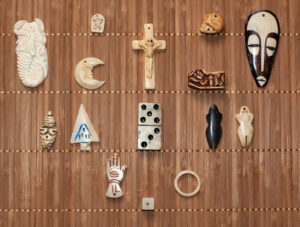
These pieces (and all the pieces shown in this section) are from my travel/teaching set and they are all made from bone. Their meanings are given at the end of the post.
Animal Bones
Animal bones can be interpreted in several ways. You can let them represent the energy of the animal they come from – for example, a lion bone can represent courage or pride. Or you can let the part of the body the bone came from guide your interpretation – a foot bone could mean travel. You could also use folk stories or mythology to assign meanings – a bird’s bone could represent the spirit world, or a message, or flying free. Pick a meaning that resonates for you even if it conflicts with the suggested meaning that came with your set. Starting out, you want to keep your meanings simple – a one or two-word meaning should be assigned to a piece, and you should not deviate from it unless you feel spirit guided to do so. If you make your meanings too long and broad, you can find yourself confused. Does the lion bone represent courage, pride, a dangerous predator, or catlike grace? But it’s from the foot – does it mean travel? You see where this is going. Pick one meaning and stick with it unless you strongly feel that in a particular reading it means something else. With experience your meanings will expand organically, but if they are too diverse and overloaded with possibilities to start, they will often result in confusion.
If you have pieces that you cannot decide about, try holding them softly in your hand, and ask them what they mean. Close your eyes and wait quietly to see what comes to you. If nothing comes in a minute or two, put it aside and try again later. If you still do not have a meaning after trying this a few times it could be that the piece does not want to be in your set. If this happens, take it out and put it aside. If you leave it in and you do not have a clear meaning for it, more likely than not it will just be a source of confusion when you see it in your readings. In the end, you will probably take it out anyway. Sooner is better.
Many people who read the bones find that what interests them most is the animals that they came from. There are readers* who are extremely sensitive to, and in tune with the spirits and characteristics of the animal pieces they work with. They know many myths and stories, and they use these to enhance their interpretations. While I read up on the characteristics and lifestyles of the animal species in my set, I am most interested in their symbolic meaning. I do not have a wide body of knowledge of animal myths and stories, so my meanings tend to be based on the lifestyle of the animal rather than the myths and stories surrounding them.
For example, people hear coyote bone and usually think trickster. This most likely comes from some of the many coyote mythologies of indigenous American people that have become so popular and well known that they
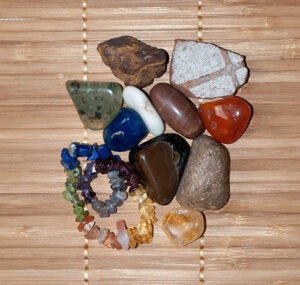
Stones and broken pottery – some purchased, some found. I use the green, blue, red, and yellow stones to represent the four elements.
may feel like a part of some generic “American” culture. I do not see coyotes as tricksters. There are coyotes where I live. They walk down my street and I am fairly certain that they have been in my own backyard. Barely a week goes by that someone does not post a picture of one on the local neighborhood app “Nextdoor,” with a warning to keep your smaller pets inside. I do not know any specific stories of coyote as trickster, though I could probably easily find several were I inclined to do so. I could also find mythologies of coyote as a creative force and as a benefactor of mankind. In my mind however, coyotes are just out there trying to survive. They don’t eat your cat to be tricky, or to be mean and cruel – they are hungry, and your kitty is food. We have encroached on their space, and they are trying to survive. That is how I interpret the coyote – as someone who may do hurtful things, but not from malice. He or she is trying to survive. My meaning is based on my personal experience with the animal.
Most of my bones are from animals indigenous to the United States. There are two reasons for this. One is that they are the animal bones most readily available to be found or purchased. But the second reason is that I like the idea that most of my bones are from native species and from the land and country that I call home.
One exception to this is my lion bone.** Lions are obviously not native to North America, but this bone hearkens back to my ancestors who were taken to North America in the Middle Passage. It is a piece that represents my roots, and the blood flowing through my veins, and my identity as a person of African descent in this country. I have European ancestors as well, but they are more than adequately represented by pieces in my set as I was born, raised, and educated in western culture.
These lines of thinking are obviously deeply personal and speak to my relationship with the pieces in my set. You may choose pieces for your set based on your own thoughts around these or other issues. If you have no thoughts around them and you just use a bone because you like the way it looks, that is fine too. Whatever works for you is the right thing to do. I do not write to prescribe how you should approach the bones in your set. Instead I am sharing thoughts and ideas that I have developed over time while working with my set. I am sure you will develop your own thoughts and understandings of the bones in your set over time as well.
The key words there are “over time.” These were not thoughts I had early in my journey with the bones. I was just excited to be learning and growing my set. It was the experience of actually working with my bones, holding them in my hands, asking them if they wanted to work with me, blowing my breath onto them, and listening to them speak, that led me to and along this line of thinking. It has evolved over a long period time – years, and my thoughts are still evolving. Some folks may have been thinking like this from the beginning. If you are one of them good for you! And if you are not one of those people don’t feel like you have to start thinking of these things or feel guilty because you haven’t done so. Let your journey unfold in its own time. It worked for me.
Sea and Other Shells
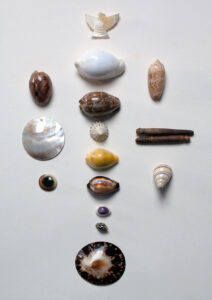
You can use a shell to represent almost anything. They come in an amazing array of colors, shapes, and sizes. The meanings for these shells are given at the end of the post.
I live near the ocean, so there are plenty of seashells available for the price of a walk on the beach. There are also lots of beach stores geared towards tourists that sell seashells from all over the world. If you do not live near the ocean you can find seashells inexpensively online. I have even gotten a basketful of shells meant for decorative use from the dollar store. By using easily distinguishable varieties you can assign different meanings to different types of shells. I like to use shells to represent people. Their different sizes and shapes make them highly suitable for this purpose. Small shells can be children, and larger shells can be adults. In my main set, I have shells to represent an unborn baby, a children (and young adults) under 20, adults in their prime (20-40 years old), middle-aged adults (aged 40-60), and elderly adults (aged 60+). I distinguish them male and female by size. A large shell represents a male and a smaller shell of the same species represents a female.
I also use shells to represent ancestors with various species of cowries for the maternal line and various types of elongated shells for the paternal side of the family. I used to use shells to represent the client as well, but then I found the small ceramic figures that I currently use.
Things Found in Nature
A simple walk can yield you a bounty of pieces. Seeds, nuts, cones, snail shells, twigs, stones, small found items – all of these can be used in your bone set. I try not to take anything from a living tree or plant for my bone sets, limiting myself to what I find on the ground. Even then I leave a small offering – a few coins, or if I am out in a natural area, I carry small jars of molasses, corn kernels, and cornmeal in my dog-walking pouch to leave at the base of the tree or plant as payment.
A quick word about snail shells. They are easy to find and often quite pretty. I have used them in my set, but I have found that they inevitably have a thin spot that will sprout a small hole. Once the hole appears, it is just a matter of time until it crumbles completely. You can try coating them with a few coats of a clear varnish of some type to strengthen the shell if you find one you want to use.
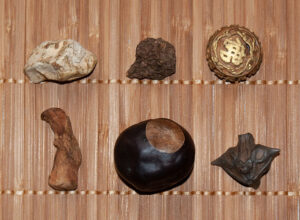
Seeds and roots
Purchased Roots, Seeds, Nuts, and Twigs
If you are a member of a tradition that uses herbs for healing, whether in an occult manner, or in a medical one, items from nature will be a natural for you to add to your set. These items are easy to find and purchase, and they each bring their own energy to a bone set. For example, Little John Root (Galangal) is used by people going to court. I have a piece in my set to represent legal matters and matters where following the law and rules is important. Everyone has heard the saying “Mighty oaks from little acorns grow.” An acorn in your set can indicate growth, or prosperity, or great things coming from small beginnings. A root, or a found branch that forms a “Y” can be used to represent having to make a choice between two paths. Many natural ingredients have strong cultural associations, and if they are dried, or otherwise preserved, they readily lend themselves to being interpreted as those associations.
You are not limited to cultural associations – a seed with an interesting shape or color may remind you of something or create its own association in your mind. While we are products of our cultures, we also have personal associations that are unique to us as individuals. There is no reason these cannot be used in our sets. In fact, pieces with personal associations are often the pieces that we feel most comfortable interpreting and explaining to our clients. We have a story that we can tell to explain the meaning of the piece.
Personal Pieces

Amphibians are often seen as symbols of transformation.
Personal pieces are pieces that you already own or purchased specifically for your bone set. Usually these are the easiest ones to assign meanings to since they usually have some personal significance in your life. You can assign them meaning based on the symbolism of the piece – a tiny frog figure can represent transformation, as frogs transform from tadpoles to frogs, or you can assign meanings from personal memory and experience. The tiny frog figure could be a childhood toy and thus represent childhood, or it could be a gift from someone who has passed on and thus represent mourning or regret. Your meanings do not have to make sense to anyone but yourself, so assign meanings that will be easy to remember whether they are the meanings one might ordinarily expect. One reader I know*** has a large, beautiful set where every piece has a story. She uses their storylines in her interpretations and readings.
When you assign meanings keep the main interpretation something short, simple, and easy to remember. Few things can initiate palm sweat like looking at a piece on the cloth or mat and having no idea what it means. I advise students to make a one or two word meaning, write it down, and remember it. If you ever get stuck in an interpretation go back to basics and use that original one word meaning.
One or Two-Sided Pieces
Most of the pieces in my set have two sides. If the “top” is showing, then the piece is speaking and I interpret it. If the “bottom” is showing, I usually interpret that piece as having nothing to say. Many things you get for your set will automatically lend themselves to a two-sided interpretation – shells, for example, but some pieces do not lend themselves to this type of interpretation unless you mark them in some way. Most animal bones fall into this category. If I have a piece that does not lend itself to a two-sided interpretation, I decide whether it needs one. In some cases, it does not. If it does, but does not easily lend itself to having two sides I will mark it in some way such that if I can see the markings I interpret it as speaking and if I can’t, it is silent.
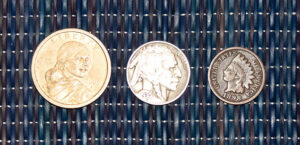
Coins are a good example of a piece that lends itself to two-sided interpretation. If the face is showing I interpret it as money coming in. If the reverse is showing – money going out. The amount is approximated by the coin. The dollar coin is a large amount of money or debt. The nickel is a medium amount of money, and the penny is a small amount of money.
I started with one coin, but quickly found that it did not give enough information. If money is coming or going, we want to know how much.
There is no rule I can give you as to which pieces, if any should be made two sided. You have to work that out for yourself. There are also different ways to interpret a piece that is face down. You can read it as silent, which is what I do most of the time. You could also interpret it as the energy of the piece being present but blocked in some way. You could also read it as the opposite of the piece’s meaning like my button/mirror piece. One side says to connect with others, the other side says look within.
What Pieces Do I need?
I don’t have an answer for that question. But you do, and you will expand and refine that answer over time. Some pieces are obvious like a piece to represent the person you are reading for, although there are readers who don’t use this piece. Aside from that, think about the main areas of your life and what you would like to know about them. Then find pieces to represent those things. Relationships – romantic, familial, and platonic are important to most people. Career and finances are areas that I commonly find that my clients want to know about. Spiritual concerns are also a common area of interest. Start with your own life interests. As time goes on and you start to read for other people you will find new areas of interest as well as existing areas where you would like more detail and you will start adding pieces to give you the detail that you desire.
If you take classes with a teacher, he or she will usually tell you what pieces you need to take their class.**** Many also provide or sell sets with the pieces you will need for their classes. ***** If you buy a starter set, start with the pieces in it and add pieces to fill in any areas that you would like to know about, but don’t have pieces for. This need not be an expensive proposition – look around your home for things to use. I would bet that you have many things that you have been saving just for this moment. Bits and bobs in you junk drawer or jewelry box, coins from your pockets, interesting stones found on walks, shells or sea glass from your beach vacation – all of these items can make great additions to your set and cost you nothing.
Starting out, building your set, finding which pieces work, and which ones don’t, assigning meanings, refining and changing those meanings – this is an exciting time in the life of a new bone reader! It is also a magical time. Pieces will come to you in unexpected ways just when you decide that you need them. Once your friends find out that you read the bones, you will most likely start to get gifts from them as well. Some of those gifts will be useful, and some not, but it will seem like the universe is conspiring to help you complete your set.
Ultimately my advice for assigning meanings is that they make sense to you, and that they be simple and easy to remember. Other than that, your only limit is your imagination.
* Kim Stoll is a reader who uses only animal bones in her set and bases her interpretations on the energy and myths of the source animals.
** The United States suspended imports of lion trophies in 2016.
*** Jo Champion of Stones, Bones, and Totems (You can purchase her book on Amazon)
****Ayele Kumari teaches beginner and advanced bone reading classes and she gives students a list of pieces they need to gather.
***** Makhosi Ateyo Nkanyezi teaches bone reading classes regularly which include a consecrated bone reading set in the cost of the class.
I have taken bone reading classes with Makhosi Ateyo Nkanyezi, Ayele Kumari, and Kim Stoll. I enjoyed each of these teachers’ classes and would recommend them. I will be listing other teachers whom I have taken classes with as this book moves along and there will be a comprehensive list as an appendix. I try to take classes whenever I find them offered and even though I have my own method, I always learn something useful by studying with others. I consider bone divination a lifelong study and I recommend that you get readings and take classes with other readers when you can.
I teach sell bone reading starter sets to my students. If you decide to take a class with me and would like to purchase a set schedule the class at least a week in advance to allow time for the set to reach you and let me know that you want to purchase a set in your booking information.

Meaning for the pieces made of bone shown above.

Meanings for the shells pictured above.
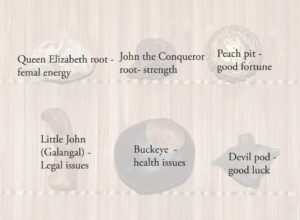
Meanings for the roots and seeds shown above.

Leave A Comment